Farm Advisory Service - One to Many: evaluation
This report provides an evaluation of the One to Many component of the Farm Advisory Service, delivered by SAC Consulting and provided as part of the Scottish Rural Development Programme 2014-2020. It analyses what has been delivered and provides recommendations for the future.
4 Findings: Views of Service Users
4.1 Summary Findings
- The survey indicates high levels of satisfaction with the service and use of the diverse services provided.
- The survey finds that many, but not all, respondents used the service for engaging on environmental improvements and business improvements. However, there was also evidence that participants may face barriers to implementing the advice they have received.
- The survey also provides several examples of clear, tangible benefits that followed the receipt of advice, including financial savings.
4.2 The Survey
To support this evaluation, we undertook a small survey of those who had engaged with the service. The survey sought to understand farmer's views of the service and the extent to which advice from FAS translated into on-farm improvements. The survey had 148 respondents. A web-link to the survey was distributed via FAS, using their website and mailing list, and boosted with the assistance of the SRN, who mentioned it in social media and their monthly newsletter.
It is important to emphasise that this is not a survey of the farming population, or indeed all those who had used the FAS service. Overall, the 2020 June Agriculture census indicates approximately 66, 800 agricultural workers in Scotland. By contrast, the combined total of those participating in FAS events is 16,183 across all five years (assuming that all attendants are unique, which is unlikely). While it would not be expected that all representatives from each holding would attend FAS events, this nonetheless indicates that there is likely to be a substantial number of farmers who do not participate in FAS events, a point reiterated within stakeholder conversations. At present, we do not have a representative survey of farmers that asks about their use of the Farm Advisory Service, which informs Recommendation 2, as above.
4.3 The Survey Sample
Given the above, we face the challenge of the sample being both non-representative of the farming population generally, but also potentially non-representative of the FAS using subset of this population. In this context, the survey is best thought of as indicative, in relation to a group who use the service, both in terms of which sorts of farmers are participating and the benefits they obtain. 145 respondents noted their primary farming enterprises. Of these:
- 60% reported that they farmed sheep
- 50% reported farming beef
- 26% reported arable farming
- 14% reported crofting.
In the 2020 June Agricultural Census, it was reported that 34% of Scottish farmers were either Less Favoured Area (LFA) or non-LFA cattle and sheep. Therefore, it appears that livestock farmers are somewhat overrepresented in this sample. Similarly, arable farmers appear to be under-represented in the survey, given that 42% of the 2020 census report general cropping as their primary activity and a further 8% report general cropping and cereal as their primary activities. Determining whether this imbalance reflects the survey sample, or whether it reflects uneven use of the FAS will be a key goal of Recommendation 2.
In terms of gender, of 144 participants who provided this information, 70 % were men and 30% were women. In the June Agricultural Census from 2020, 32% of the total farming workforce (where gender information is available) are female. Therefore, while women remain under-represented in the sector as a whole, the survey reflects the gender balance in farming reasonably well. For context, the FAS annual report for 2019/20 indicated that men were slightly over-represented as participants, at 63%, although this has decreased from 70% in 2018/19.
In terms of farm tenure, 13% reported having operated their farm for less than two years, with approximately 29% in each of the remaining categories (3-9 years, 10-25 years, and over 25 years). The survey also asked about the number of employees, including family labour, that respondents had on their farms, to provide an indication of the size of their enterprise. The results are shown below:
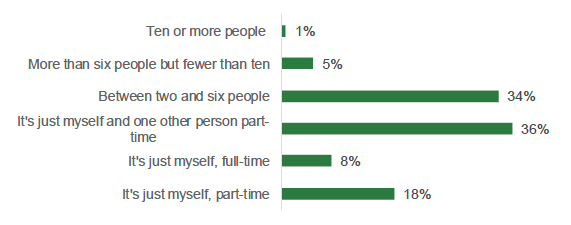
As these results show, just over a third of the respondents had at least one employee, with a total of 39% having full-time employees, and a further 36% having a part-time employee. By contrast, the June agricultural census from 2020 indicates that only 18% of farms in Scotland have employees, and that only 11% of these have full-time employees. This suggests that our sample under-represents sole operator farmers and raises the possibility that this group are underrepresented in usage of the FAS. Provided that Recommendation 2 is considered and data on FAS users can be generated, this in turn could facilitate a strategy to ensure that those currently under-represented with the service are engaged. This underpins Recommendation 3.
Recommendation 3: Review Engagement Strategy. Consider contractual mechanisms that support the goal of engaging with those who are under-represented in FAS, and the possibility of requiring a detailed engagement strategy that examines subjective and structural barriers. Review whether future farm advice should develop an appropriate customer management system that reports customer characteristics, allows monitoring that tracks additional advice and engagement from customers, to monitor crossover between the different components of the service (the latter in the event that delivery continues to be split into FAS: One to Many and FAS: One to One).
4.4 What did the sample use the FAS for?
As indicated in the previous chapter, a particularly impressive element of FAS delivery has been the development of a wide-ranging offering that provides multiple formats in which information is available, while at the same time ensuring that people throughout Scotland have access to in-person events. Respondent levels of participation in FAS services can be seen in Figure 4.2.
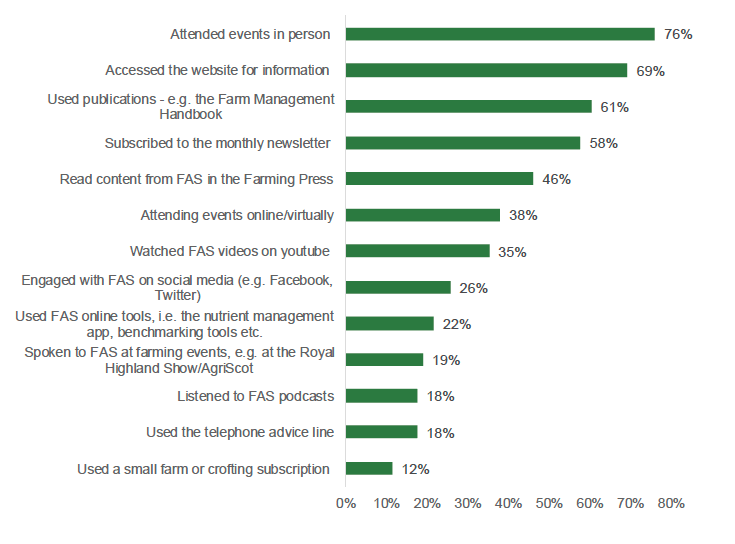
This indicates the range of services provided by FAS that are in use, albeit to differing degrees. In-person events were ranked as the most important feature of delivery by 64% of respondents.[5]
We also asked whether engagement with FAS OtM supported additional use of the FAS one-to-one service. Within the sample, however, 39% of the respondents (n = 123) had not used any additional services in the one-to-one offering as a result of interacting with the one-to-many service. The fact that the majority had used both is encouraging but suggests there is scope for greater integration. See Recommendation 3, above, for further discussion of this.
Participants were given the option of filling in a free text box asking "Are there any topics you are interested in getting advice from FAS about that are not currently provided for?". While only 18 participants filled in this part, common themes included: how to make a living from farming at a small scale, more detailed and specific advice that is tailored, innovation and development, succession, technology and greater technical detail.
4.5 Overall Sentiments
Several of the survey questions requested overall impressions of the service. On the question of overall satisfaction, over 75% of the respondents were either very or somewhat satisfied with the FAS, with a further breakdown in Figure 4.3.
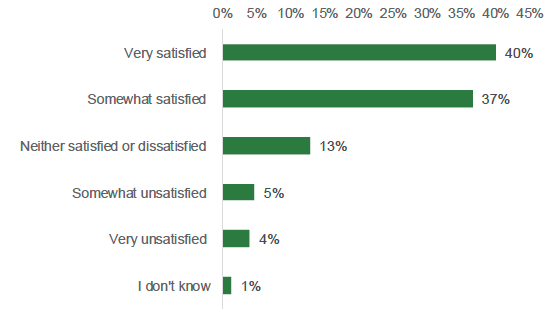
Participants were also asked how likely they were to continue using the service in the future. Here, 59% reported that they were 'very likely' to do so, 25% were somewhat likely, while only 5% in total were either somewhat or very unlikely to continue using it. The survey also asked for specific sentiments on how the quality and accessibility of information was perceived (see Figure 4.4). While satisfaction is high throughout, it is worth highlighting that over one in ten of the respondents disagreed that they find it easy to access the information they needed from FAS. It will be important going forward to ensure emphasis is placed on making information easily accessible and understanding customer journeys.
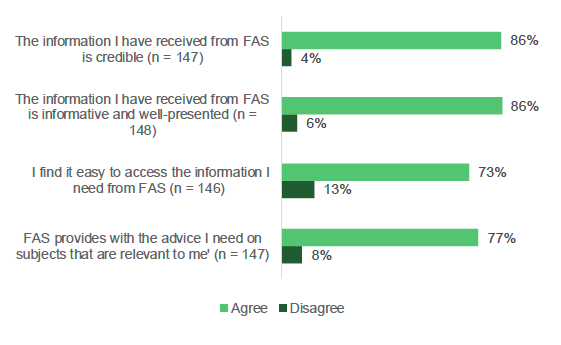
The survey also found that the sample drew on a wide range of information, in addition to FAS, to support their farm businesses. While vets are the most important source of information (see Figure 4.5), nearly 70% of the respondents here also engage with agricultural consultants and 45% engage with Agronomists. As this shows, FAS is one of many sources of information for farmers.
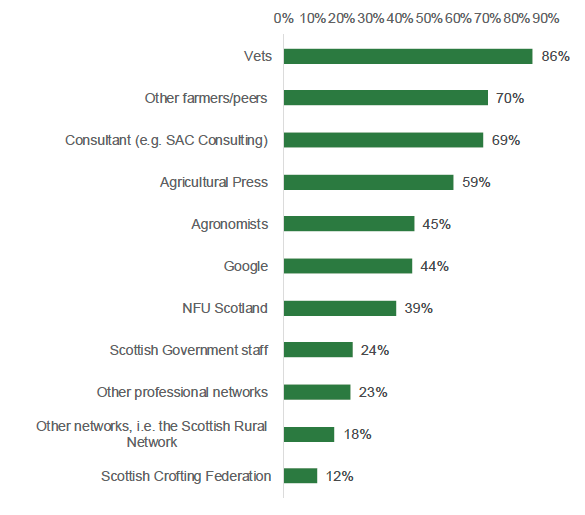
4.6 Business Impacts
The survey also queried the benefits participants had obtained from using the service. Within the sample, 61% had used FAS to access information on improving the performance of their farm business, and 40% had not. Of those (n = 89) that had, 71% agreed it had made them more confident in their business abilities, and 70% said that the information had been financially valuable. The specific benefits received can be seen in Figure 4.6.
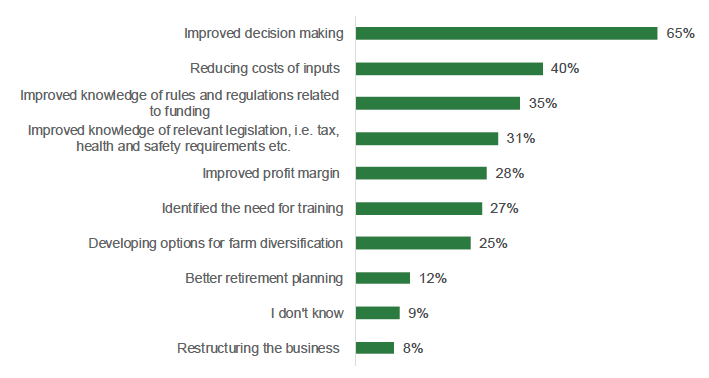
While 'Improved Decision Making' is the most common, 40% ('reducing costs of inputs') and 28% of participants ('improved profit margin') report clear financial benefits from their engagement. It is challenging to interpret these numbers. The high incidence of 'improved decision making' may reflect that this is applicable to a wide range of events, as compared to some of the more specific benefits. For example, while the 12% who report 'Better Retirement planning' may represent a fraction of those who have attended these events, it may also represent all those within the sample who attended events on this, but in a context where overall participation was relatively low. It is also worth noting that over half - 52% - of those who had used the service in this way had saved money as a result (although 35% did not know if they had saved money).
However, this section also found numerous barriers perceived by participants to improving their farm businesses. Of the 80 participants who answered our question regarding whether they had wanted to make changes but been unable to, 84% reported some barriers. The most common reason given was that changes were too expensive - reported by 23% of the respondents - while others cited a lack of time, (13%). In addition, 5% cited being unconvinced of the benefits, 5% cited a lack of time, while 20% and 18%, respectively, cited a combination of the above reasons and other reasons for not implementing changes. The barriers to adopting advice are discussed in chapter 5.
4.7 Environmental benefits
The survey also asked whether participants had sought information on improving the natural environment on their farm, of which 47% of respondents had. We further asked this group about whether they had learned about specific areas and if, in turn, this had resulted in them making changes on their farm. Figure 4.7 shows the subset of those who had used the service to improve their farms' natural environments and the impacts this had had.
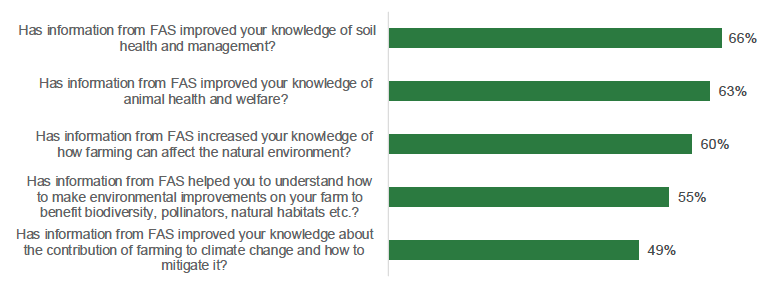
In Figure 4.8, by contrast, we can see alternative responses among this group, i.e. not learning from FAS but making changes anyway, or learning from FAS but not making changes.
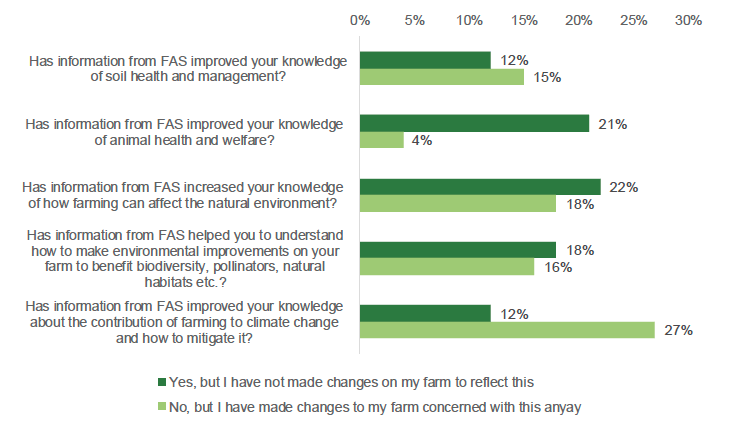
This indicates both that participants are making changes, albeit ones that are difficult to monitor, as a result of their engagement, but also that there are contexts where they may be convinced of benefits but unable to implement changes.
4.8 Views on Future Delivery
Finally, the participants were asked for views on future delivery (n = 147). We were curious to understand whether some participants were opposed to virtual meetings. While 50% indicated that they had no strong preference, and 14% actually preferred these meetings, 15% reported that they disliked these sorts of meetings, while a further 16 % reported that they struggled with this format owing to connectivity issues. When asked what they wanted more of, 'in person' meetings received the highest endorsement, with 51% wanting either 'a bit more' or 'a lot more', with only 4% wanting less. Conversely, 14% wanted either a bit or much less online meetings, with 36% wanting more. Further responses regarding their preferences can be seen in Figure 4.9.
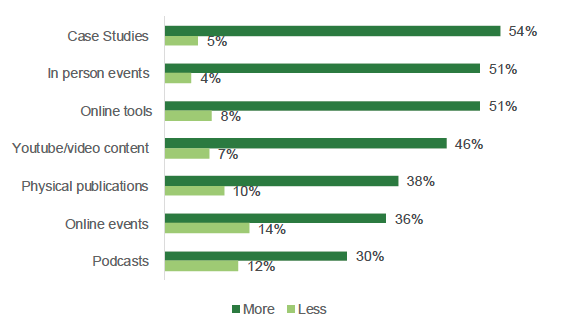
4.9 Conclusions
This survey suggests that the sample were satisfied with FAS, used a wide range of services and that many had made changes to their farming enterprises as a result of their engagement. However, it also underlines the need for robust data on FAS use, and indicates that, even for those who are actively seeking to improve their farm in terms of its environment or competitiveness, there may be important barriers to achieving this. The question of how we might address these barriers is discussed in chapter 5.
Contact
Email: joseph.ritchie@gov.scot
There is a problem
Thanks for your feedback